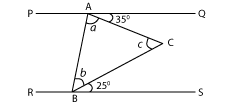Plans
Dashboard
Daily & Speed
Quant
Verbal
DILR
Compete
Free Stuff
Lines And Triangles
MODULES
Lines & Angles
Parallel Lines
Basics of Triangles
Types of Triangles
Triangle & its Segments
Area of a Triangle
Isosceles & Equilateral
Right-angled Triangles
Other Theorems
Congruency & Similarity
Past Questions
CONCEPTS & CHEATSHEET
Concept Revision Video
SPEED CONCEPTS
Lines & Triangles 1
-/10
Lines & Triangles 2
-/10
Lines & Triangles 3
-/10
PRACTICE
Lines & Triangles : Level 1
Lines & Triangles : Level 2
Lines & Triangles : Level 3
ALL MODULES
CAT 2025 Lesson : Lines & Triangles - Parallel Lines
2.1 Parallel Lines & Transversal
The concept and properties of parallel lines and transversal will be used across geometry. These properties are used to prove many geometrical theorems.| Parallel lines are two or more line that do not intersect each other. The distance between parallel lines remains the same throughout the plane they belong. |  |
| Two or more lines that make the same angle with respect to another common line are parallel to each other. |  |
In the figure above, lines AB, CD and EF subtend the line l at 30°, so they are parallel and the line l, which intersects the parallel lines, is called the transversal.
In a system with 2 or more parallel lines and transversals, an intercept is the distance, measured on the transversal, between 2 parallel lines. In the figure, BD, DF and BF are the intercepts.
In the below figure, AB | | CD | | EF and l & m are the transversals. PQ & QR are the intercepts on l and XY & YZ are the intercepts on m.
According to Basic Proportionality Theorem, PQ : QR = XY : YZ

In the following figure, we observe the types of angles formed in a system with parallel lines and transversals.

When parallel lines AB & CD are intersected by a transversal l
| Corresponding angles are equal | ∠1=∠5,∠2=∠6 ∠3=∠7,∠4=∠8 |
| Alternate Interior angles are equal. | ∠3=∠6,∠4=∠5 |
| Alternate Exterior angles are equal. | ∠3=∠8,∠2=∠7 |
| Interior angles on the same side of the transversal are supplementary. | ∠3+∠5=180° ∠4+∠6=180° |
| Exterior angles on the same side of the transversal are supplementary. | ∠1+∠7=180° ∠2+∠8=180° |
| Vertically Opposite Angles (formed when two lines intersect) are equal. | ∠1=∠4, ∠2=∠3 ∠5=∠8, ∠6=∠7 |
Example 4
| In the following figure, AB, CD and EF are parallel lines. What is the length of BF? |  |
Solution
Let BF = x cm5020=x12 ⇒ x=30
Answer: 30 cm
Example 5
In the following figure, PQ | | RS. Then, ∠C = ?

Alternatively
Answer: 60°

Solution
If we draw a parallel line TU which passes through C, then  |
∠QAC = ∠ACT = 35° (Alternate interior angles are equal) ∠SBC = ∠BCT = 25° (Alternate interior angles are equal) ∴ ∠ACB = 35°+25° = 60° |
Alternatively
 |
If we join AB, this becomes the transveral. QAB + SBA = 180° (Interior angles ) a+b = 180°−25°−35°=120° a+b+c=180° (Sum of angles of a triangle) ⇒ c=180°−120°=60° |
Answer: 60°
Want to read the full content
Unlock this content & enjoy all the features of the platform
Subscribe Now